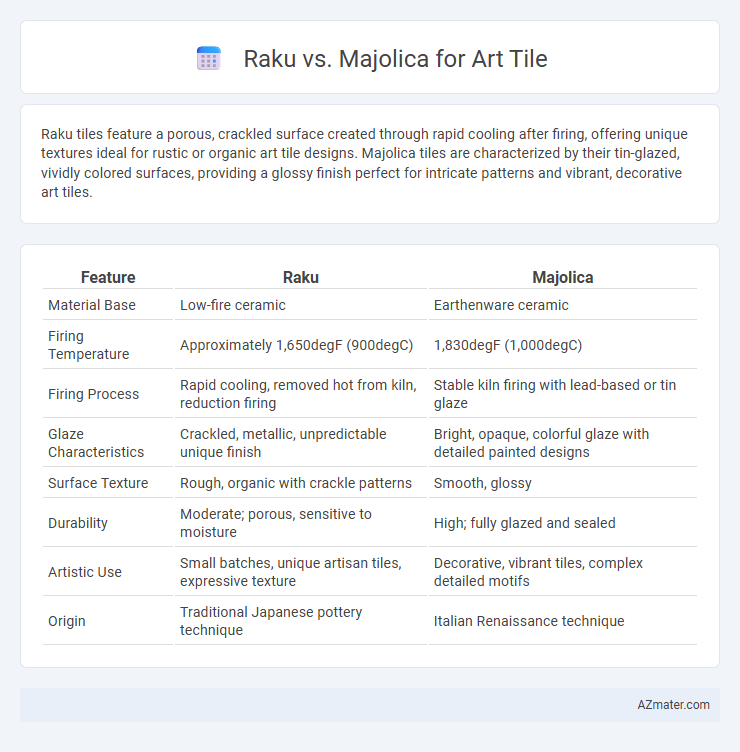Raku tiles feature a porous, crackled surface created through rapid cooling after firing, offering unique textures ideal for rustic or organic art tile designs. Majolica tiles are characterized by their tin-glazed, vividly colored surfaces, providing a glossy finish perfect for intricate patterns and vibrant, decorative art tiles.
Table of Comparison
| Feature | Raku | Majolica |
|---|---|---|
| Material Base | Low-fire ceramic | Earthenware ceramic |
| Firing Temperature | Approximately 1,650degF (900degC) | 1,830degF (1,000degC) |
| Firing Process | Rapid cooling, removed hot from kiln, reduction firing | Stable kiln firing with lead-based or tin glaze |
| Glaze Characteristics | Crackled, metallic, unpredictable unique finish | Bright, opaque, colorful glaze with detailed painted designs |
| Surface Texture | Rough, organic with crackle patterns | Smooth, glossy |
| Durability | Moderate; porous, sensitive to moisture | High; fully glazed and sealed |
| Artistic Use | Small batches, unique artisan tiles, expressive texture | Decorative, vibrant tiles, complex detailed motifs |
| Origin | Traditional Japanese pottery technique | Italian Renaissance technique |
Introduction to Art Tile Techniques
Raku and Majolica represent distinct art tile techniques rooted in unique firing processes and surface treatments. Raku involves rapid firing and cooling, producing unpredictable crackles and metallic lusters that emphasize organic textures and spontaneous patterns. Majolica uses tin-glazed earthenware with vibrant, opaque colors and intricate painted designs, offering a controlled decorative surface ideal for detailed artistic expression.
Overview of Raku: History and Characteristics
Raku is a traditional Japanese pottery technique dating back to the 16th century, originally developed for tea ceremonies. Its hallmark is the rapid firing and cooling process, which produces unique crackled glazes and unpredictable surface textures. Raku art tiles often showcase organic forms and asymmetrical shapes, embodying a wabi-sabi aesthetic that celebrates imperfection and natural beauty.
Majolica: Origins and Defining Features
Majolica, originating in the Renaissance period of Italy, is characterized by its tin-glazed earthenware that produces a vivid, opaque white surface ideal for colorful, detailed designs. This art tile technique is distinguished by its bright, glossy finish and intricate hand-painted motifs, often featuring floral patterns and historical themes. Unlike Raku, which emphasizes a smoky, crackled aesthetic through rapid cooling, Majolica showcases a smooth, vibrant palette that highlights the precision and artistry of its painted decoration.
Material Differences: Clays and Glazes
Raku art tiles are crafted using porous clays that tolerate rapid cooling and thermal shock, paired with low-fire glazes that crackle uniquely during the reduction firing process. Majolica tiles utilize white or buff earthenware clays, renowned for their smooth, absorbent surface, and are coated with opaque, glossy tin-based glazes decorated with vibrant, colorful patterns. The material contrast lies in Raku's emphasis on spontaneous glaze effects and rugged clay bodies versus Majolica's refined clay texture and meticulously applied, bright glazes.
Firing Processes: Raku vs Majolica
Raku firing involves rapid heating and cooling cycles, often removing tiles from the kiln while red-hot and placing them in combustible materials to create unique crackle effects and metallic finishes. Majolica firing utilizes a slower, more controlled oxidation process with a tin glaze applied before firing at lower temperatures, producing vibrant, opaque colors and a glossy surface. The distinct firing temperatures and atmospheres in Raku and Majolica significantly influence tile texture, durability, and visual aesthetics in art tile applications.
Color and Finish Comparisons
Raku tiles offer a distinctive, crackled finish with metallic and smoky color variations resulting from rapid cooling, creating an organic and unpredictable surface ideal for unique, artistic expressions. Majolica tiles feature vibrant, glossy glazes with bold, saturated colors and smooth finishes achieved through tin-glazing techniques, providing a rich, decorative appeal often used in traditional and Mediterranean designs. The color palette of Raku emphasizes earthy tones and iridescent effects, while Majolica showcases bright blues, yellows, and greens with a consistently shiny finish, making each suitable for different aesthetic preferences in art tile applications.
Durability and Practical Applications
Raku tiles, known for their distinctive crackled glaze and rapid cooling process, offer moderate durability suitable for decorative indoor applications but are less resistant to heavy wear and weather exposure. Majolica tiles, characterized by their tin-glazed, brightly colored surfaces, exhibit higher durability with strong resistance to moisture and abrasion, making them ideal for both indoor and outdoor installations. When selecting art tiles, Majolica provides better longevity and practical use in environments requiring robust material performance.
Aesthetic Appeal: Artistic Styles and Trends
Raku tiles showcase a raw, organic aesthetic with unpredictable glaze effects and crackled textures, aligning with contemporary, wabi-sabi-inspired design trends that celebrate imperfection and natural beauty. Majolica tiles, characterized by vibrant, hand-painted patterns and glossy finishes, evoke Mediterranean and traditional European artistic styles, appealing to those seeking bold color and intricate detail in their art tiles. Both styles remain popular among designers for their unique ability to transform spaces through distinct visual narratives, with Raku suited for rustic, eclectic interiors and Majolica favored in classic, decorative schemes.
Suitability for Outdoor vs Indoor Use
Raku tiles, known for their porous nature and thermal shock resistance, are best suited for indoor decorative art due to their vulnerability to weathering in outdoor environments. Majolica tiles, characterized by their glazed surface and durability, excel in both indoor and outdoor applications, offering superior resistance to moisture and temperature fluctuations. Choosing Majolica for outdoor art installations ensures long-lasting vibrancy, while Raku remains a favored choice for indoor settings where controlled conditions preserve its unique finish.
Choosing the Right Technique for Your Art Tile Project
Raku and Majolica are distinct ceramic techniques offering unique aesthetics and firing processes, essential for selecting the ideal method for your art tile project. Raku firing produces unpredictable crackled surfaces and metallic lusters through rapid cooling, ideal for rustic or organic designs. Majolica involves applying vibrant, opaque glazes on white earthenware, perfect for intricate, colorful patterns demanding precise detail and durability.

Infographic: Raku vs Majolica for Art Tile
 azmater.com
azmater.com